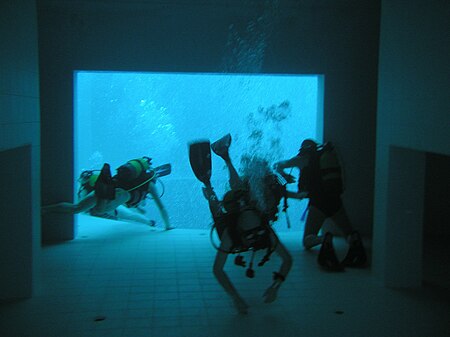Nemo 33

Nemo 33 is an indoor non-chlorinated fresh water facility in Brussels, Belgium. It held the record as the deepest indoor swimming pool in the world between its opening on 1 May 2004, and the completion of Y-40 in Montegrotto Terme, Padua, Italy on 5 June 2014.The pool's maximum depth is 34.5 metres (113 ft). It contains 2,500,000 litres (550,000 imp gal; 660,000 US gal) of non-chlorinated, highly filtered spring water, maintained at 30 °C (86 °F) by a solar heater, and holds several simulated underwater caves at the 10 metres (33 ft) depth level. Due to the warm temperature in the pool, divers can dive for extended periods without a dry suit. The complex was designed by Belgian diving expert John Beernaerts as a multipurpose diving instruction, recreational, and film production facility in 2004. Popular Mechanics rates Nemo 33 as one of the top 18 strangest pools in the world.
Excerpt from the Wikipedia article Nemo 33 (License: CC BY-SA 3.0, Authors, Images).Nemo 33
Rue de Stalle - Stallestraat,
Geographical coordinates (GPS) Address External links Nearby Places Show on map
Geographical coordinates (GPS)
| Latitude | Longitude |
|---|---|
| N 50.796211 ° | E 4.316468 ° |
Address
Nemo 33
Rue de Stalle - Stallestraat 333
1180
Belgium
Open on Google Maps










